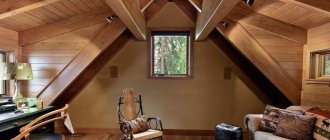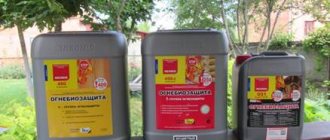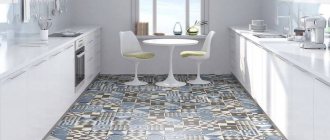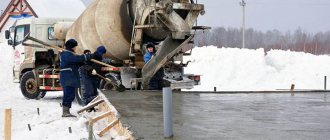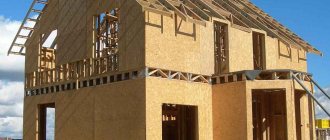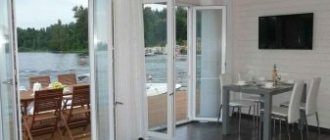Effectively protecting foundations and basement walls from underground and above-ground water sources can save a home owner a lot of time, stress and money. Protecting your home from moisture entering the foundation or basement is, first of all, an investment in your own health, because pathogenic fungi and mold develop in homes with high humidity. What is important is that waterproofing foundations can be carried out not only in a new house, but also during its renovation or reconstruction, although the cost of such work will be higher.
In this article we will continue our study of the most effective waterproofing methods. Moreover, their range today is quite large: bitumen mastic, Vilaterm, bitumen primer, roofing felt, geomembrane, gidroisol, Dysperbit and many others.
Types of waterproofing bases
Undoubtedly, any house structures located underground, as well as at ground level, must be properly protected from moisture and groundwater.
How to choose the right waterproofing system? The key factors are:
- soil and water condition (groundwater level, soil composition);
- foundation method (foundation base and floor on foundation, bottom slab);
- type and condition of the foundation (what the foundation wall is made of);
- as well as the presence of dilatation and penetration into the pipes.
Types of waterproofing for cottages are very diverse, they may differ:
- by methods of intended use;
- by methods of laying the layer (horizontal or vertical waterproofing);
- by type of materials used (mineral waterproofing, bitumen or plastic-based waterproofing).
The sequence of work when insulating the walls and foundation of a basement is determined by the correct implementation of foundation protection and usually depends on the method adopted, the scope of work and the type of insulating material. This should be indicated in the project, without which waterproofing the house makes no sense. Careful analysis of this data will allow you to select the optimal system and material type.
GOST requirements for moisture protection of buildings and structures
There are approved rules and recommendations for foundation waterproofing. They are enshrined in the following regulatory documents:
- GOST 27751-2014;
- SP 250.1325800.2016;
- SP 72.13330.2016.
The standards provide for different waterproofing schemes depending on the type of foundation, as well as general requirements:
The insulation thickness should vary from 3 to 6 mm.- The material is applied to concrete with a moisture content of up to 4%.
- Waterproofing work can be carried out at temperatures from -30 to +30, but the recommended temperature for bitumen is from +19 to +29.
- Waterproofing can only be applied to a clean, dry surface after the primer has completely dried.
- The recommended drying time for liquid insulation is 28 days.
- Rolled waterproofing is laid overlapping to strengthen the protection of the seams.
- The implementation of insulation by the contractor must be supported by a certificate of completion of work.
The regulatory documents do not indicate that insulation is a type of work that requires special skills or training. Although work with bitumen must be carried out in compliance with fire safety rules. This means that you can waterproof a private house yourself.
How to choose waterproofing for your home?
Much depends on the design of the building. Thus, in houses without basements, the floor level in utility rooms is always higher than the surface, so water can threaten its premises only in the event of flooding. In such houses, waterproofing is laid only horizontally on the external and internal walls of the foundation, above ground level.
In houses with a basement, waterproofing must be mandatory. With it we protect the structure not only from capillary moisture, but also from groundwater, the level of which can change throughout the year. The basic rule to ensure effective protection against water intrusion is to create a waterproof waterproofing tank extending from the ground surface through the external walls to the basement floor.
Many owners of cottages with basements and basements note that they often encounter not only dampness on the lower floors, but they are also colder. This happens because insulation and wall materials lose their heat-insulating qualities due to excess moisture. It is possible to effectively insulate a basement only if you have an effective waterproofing system.
Of course, you can completely abandon the idea of a basement in the house. However, this is often necessary - this may be due to the uneven terrain of the site on which we are going to build a house, or its size. On a small site it is difficult to build a building that takes into account all the rooms and spaces we need. Then a basement or basement turns out to be an indispensable solution. The method of waterproofing them also depends on what type of foundation we choose for them (supports, strip or slabs).
If the house is already on a foundation, then 3 layers of waterproofing should be used: 2 horizontal and 1 vertical.
The first horizontal one is placed on the base of the foundation. You must place the right amount of waterproofing agent in such a way that it can be combined with two other waterproofing agents, which will ensure a perfect sealing of the entire structure. Horizontal floor insulation is used to prevent water from seeping into the floor - it is laid on structural concrete slabs.
The last thing is vertical wall insulation. If the building is on a foundation slab, then it is easier to make it. Simply install vertical and horizontal insulation and join them together.
Foundation protection with polyurea
Polyurea is a multicomponent organic polymer. Components: isocyanate, polyester amine resin.
To apply polyurea, you will need special equipment that provides heating before spraying the components to a temperature of >+80 degrees, separate supply to the mixing chamber of the gun and to the treatment site under a pressure of >1.7 atm.
Polyurea is applied for horizontal and vertical waterproofing.
After connecting the components and contacting the surface to be treated, the mixture hardens within 10 seconds. A durable layer is formed, similar to hard rubber or plastic.
Characteristics of the resulting polyurea layer:
- thickness: 0.5—2.5 mm;
- Full readiness for use 1 minute after application;
- no seams;
- operating mode from -60 to +250 degrees;
- strength up to 80 Shore D;
- corrosion and abrasion resistant coating;
- service life >30 years.
What materials are best for waterproofing?
Materials used in waterproofing dachas and cottages must have excellent moisture resistance, strength and resistance to compounds found in the soil.
The most popular solutions are the use of resin and bituminous masses, which are easy to apply and, in addition, after a short time they make it possible to bury the foundation. Even today there are many varieties of rolled materials (hydroizol, hydrostekloizol, elastoizol, isoplast, uniflex, etc.), which also effectively protect surfaces from moisture. They should be applied to sand-cleaned (sandblasted) floors and walls, although for the walls it is still necessary to apply leveling plaster to them. Bituminous masses are applied with a wide brush or putty, depending on the type of preparation chosen.
There are also mineral and plastic waterproofing in the form of:
- sludge;
- concrete mixtures;
- foil;
- membranes
To obtain the highest quality waterproofing, it is recommended to use polymer bitumen coatings or slurry or micro-mortar.
If the house was built on a site with a low groundwater level, then the foundations are not subject to severe destruction. In such cases, it will be enough to make waterproofing from bitumen mass. In buildings in areas with changing groundwater levels, reinforced insulation should be used, for example, two layers of bitumen felt.
If your site has a high groundwater level, the risks of building a house on it are very high. You should not rely only on yourself and advice via the Internet; it is better to order the geology of the site and invite professionals.
Advice : Do not skimp when choosing waterproofing materials. Better insulation may be expensive, but it is necessary because such material can protect our home effectively and for a long time. If the waterproofing is destroyed, replacing it is difficult and expensive, so it’s worth stocking up on the most durable materials.
Glass and rubber in liquid form - water will not penetrate into the basement!
Liquid glass is a mixture of soda, sand and sodium silicate in powder form. Before use, it is dissolved with water in certain proportions (the specific amount of added liquid is specified by the manufacturer). The technology for using liquid glass is simple - we clean the bases that need to be protected from moisture, cover all gaps, joints, corners and other areas with the diluted composition. We wait a couple of hours and enjoy the high-quality waterproofing.
Liquid glass is only allowed to be used on concrete surfaces! Constructions made from other materials are incompatible with this water protector.
Let us add that liquid glass has unique repairability (if necessary, you can dismantle part of the waterproofing and install new protection in its place) and excellent anti-corrosion characteristics. The only unpleasant moment. The liquid composition, after dilution, sets quickly enough and becomes unsuitable for use. Therefore, it should be stirred in small portions. And immediately use them for their intended purpose.
Liquid rubber is made from a variety of polymer elements and bitumen. It guarantees a high-quality moisture barrier both inside and outside the basement. Rubber waterproofing coatings have the following advantages:
- complete absence of rotting;
- uniquely high adhesion to the base;
- durability;
- affordable price;
- resistance to water pressure, ultraviolet radiation and temperature changes;
- maintainability;
- fire safety.
Treating basements with liquid rubber is easy to do yourself. We remove fungi, dirt and dust from surfaces. We level the bases that we want to treat (the operation is optional, but it will reduce the consumption of insulating material), apply a primer composition to them. There is a nuance here. First you need to prime the existing gaps and corners. Then cover the surface with a fabric sheet (sold in construction stores). And after that, apply the primer again, covering the entire base.
Liquid rubber creates a high-quality waterproof barrier
After 4 hours we can begin waterproofing the subfloor with liquid rubber. It is distributed along the walls of the basement with a roller. You can rent a special unit for spraying liquid rubber. Then the work will go much faster. If you are protecting an ordinary cellar in a private house from water, there is, of course, no real need to use this installation. The time for complete hardening of liquid rubber is several hours. As a result, a special film is formed on the treated surfaces, through which not a drop of water can penetrate. The protective coating can be finished with almost all known decorative materials.
Disperbit. What it is? How to choose?
When waterproofing a house, it is recommended to use only the best and highest quality materials so that the protective layer is as resistant to all external factors as possible. For this reason, many private home developers have turned their attention to a product called Disperbit. Let's look at it in more detail.
Disperbit is a so-called dispersion waterproofing based on bitumen-rubber mass. It consists of bitumen which is suitably modified using synthetic rubber. It has proven itself to be an excellent material for the preparation of durable waterproofing coatings.
Why do you need disperbite? First of all, to protect such elements of the house as the roof, foundation, walls, bathrooms and more.
What are the advantages of disperbite? The first thing worth noting is that it can be applied to walls immediately, without heating. This creates a highly flexible coating that is resistant to water and variable temperatures, and is non-invasive to materials such as polystyrene. However, this waterproofing material cannot be applied at low temperatures (below +10 degrees), or in rainy weather.
How to apply waterproofing material?
Before applying the waterproofing coating, you must thoroughly clean the surface. Any possible defects in the structure of the treated walls, floors and other surfaces must be eliminated (cracks and pits repaired, and the surface leveled).
Disperbit is applied in several layers - the first is used to prime the material, so the product should be diluted with water (1:1 ratio), then subsequent main layers are applied (without dilution). Each of them should be about 1 mm thick.
Wait until the previous one has dried before applying another coat. After this time, the product changes color from brown to black. If the coating is applied to the roof, it must be sprayed upon completion of the work.
We also note that Disperbit dries well on its own. However, in the case of working with roofing coverings, we must also cover the last layer with roofing paper, which will further strengthen the waterproofing.
Let's look at some more answers to the most common questions here:
- How long does it take for waterproofing coating to dry? Drying time for one millimeter layer of agent usually lasts about 5-6 hours;
- What is the product consumption? If we decide to apply 1 mm coating once, the consumption will be about 1 kg per square meter. However, it should be taken into account that effective protection will be obtained with two coatings, that is, using approximately 2 kg per square meter;
- What is the price of dispersant? A package containing 20 kg of product costs about 800-1000 rubles;
- Is disperbite harmful? No. It is completely non-toxic and non-flammable, so it does not pose a threat to our health;
- Does Disperbit dissolve foam? Due to its structure and composition, it in no way destroys polystyrene foam, so it can also be used for such coatings;
- Can Disperbit be used indoors? Yes, confirmation of this fact is the corresponding certificate that the product has;
- Which is better - Disperbit or Abizol? Analyzing both indicators, it should be emphasized that disperbite, first of all, is more friendly for the developer. It does not emit an unpleasant odor and is in no way dangerous. It should also be emphasized that abizol is a more material-intensive product.
That's all. We hope that we have answered your question: “What is the best material for foundation waterproofing?” For more detailed information on the selection of waterproofing materials, please contact specialized companies.
Did you find this article helpful? Please share it on social networks: Don't forget to bookmark the Nedvio website. We talk about construction, renovation, and country real estate in an interesting, useful and understandable way.
Video description
The video shows how to use injection insulation:
Liquid glass
The technology is universal and suitable for concrete, metal and wooden structures. Raw materials have a number of advantages:
- penetrates deeply, hardens quickly and completely fills wall voids, crystallizes from the outside and requires little time and material consumption;
- reduces moisture absorption;
- provides chemical and biological protection of walls.
Surface preparation
The main problem that a master faces when working with the foundation of a built house is the need to destroy the blind area and remove the existing finishing. If possible, the foundation should be excavated to its foundation. Next, to ensure good adhesion of the protective coating to the structure, the surface is thoroughly cleaned of soil and debris.
Inspecting the integrity of the structure, repair all cracks and chips on the surface, first using a primer, then a special plaster. The application of the protective coating begins only after the repaired areas have hardened. Waterproofing the foundation of an old house can be done in several ways.
We make a blind area with our own hands
An example of a blind area with an external drainage outlet
To make high-quality concrete protection of a foundation structure from excessive surface moisture, you will need the following materials and a set of tools:
- components for preparing concrete (small crushed stone, sand, portlad cement);
- gravel (large crushed stone);
- board for making formwork;
- large metal or polymer mesh for reinforcement;
- concrete mixer;
- rule;
- Master OK;
- plaster float;
- tools for excavation work.
Creating a cement blind area with reinforcement.
Working steps are performed in this order.
- Dig a trench and select soil around the perimeter of the building (width about 80 cm, depth about 20-25 cm).
- Cover the bottom of the trench with coarse crushed stone in a layer of 10-15 cm, pour sand on top so that its top is slightly below the soil level.
- Moisten the bedding generously with water and install the vertical formwork. Lay mesh for reinforcement.
- Prepare concrete in a ratio of 4:2:1, where, respectively, fine crushed stone (screenings), sand and M-400 cement. The consistency of the solution is semi-liquid.
- Pour concrete between the house and the formwork and level it in two perpendicular directions.
- When the concrete has set a little, rub the surface with a plaster float.
Important. If the blind area is done in the summer season, you need to protect the concrete from drying out quickly. To do this, the concrete structure (after the solution has set) must be covered with dark plastic film or some kind of dense fabric. When covering with a cloth, it is advisable to wet it daily. If these conditions are met, the concrete will gain maximum strength, which will greatly increase the durability of the blind area.
Ways to eliminate possible errors
One of the common mistakes that novice builders make is neglecting horizontal waterproofing. This will soon affect the quality of the basement masonry. This problem can only be solved with the help of injectable formulations, which are expensive and require the use of specialized equipment. Therefore, waterproofing should be taken care of even at the stage of building a house.
There is a second option to solve the problem - partial dismantling. But this is a rather labor-intensive and lengthy process. To do this you will need:
- remove the part of the brickwork closest to the foundation;
- then the rolled material is laid on the surface of the foundation;
- the masonry is returned to its place;
- All seams are carefully sealed.
Work on the next section can be carried out only after 20 days, when the masonry mortar has thoroughly hardened.
To avoid problems, it is necessary to select only high-quality waterproofing materials and strictly follow the installation or application technology.
Preparation for insulation work
Work on insulating the foundation of a built house differs from the technology that is used during the construction of the house. And the first difference is that work should begin by clearing the surface to be treated of soil. It is necessary to excavate the foundation, after which you will understand the condition of the structure and the need for preliminary repairs of the concrete surface.
The house and foundation slabs should be inspected for cracks that lead to dampness in the basement or cellar. When defects are identified, they should be covered up and the unevenness should be leveled with cement mortar. When the cement has set, you can proceed to waterproofing the foundation of an already built house with your own hands. Read on to learn how to do this correctly.
General technical rules
There are a number of technical requirements for each insulation method.
- It is imperative to take into account the height of surface water.
- Consider the purpose and operating conditions of the facility.
- Consider the possibility of floods or heavy precipitation.
- Take into account the properties of the soil during frosts.
The optimal method of protecting a strip foundation should combine vertical waterproofing in combination with horizontal type protection.


